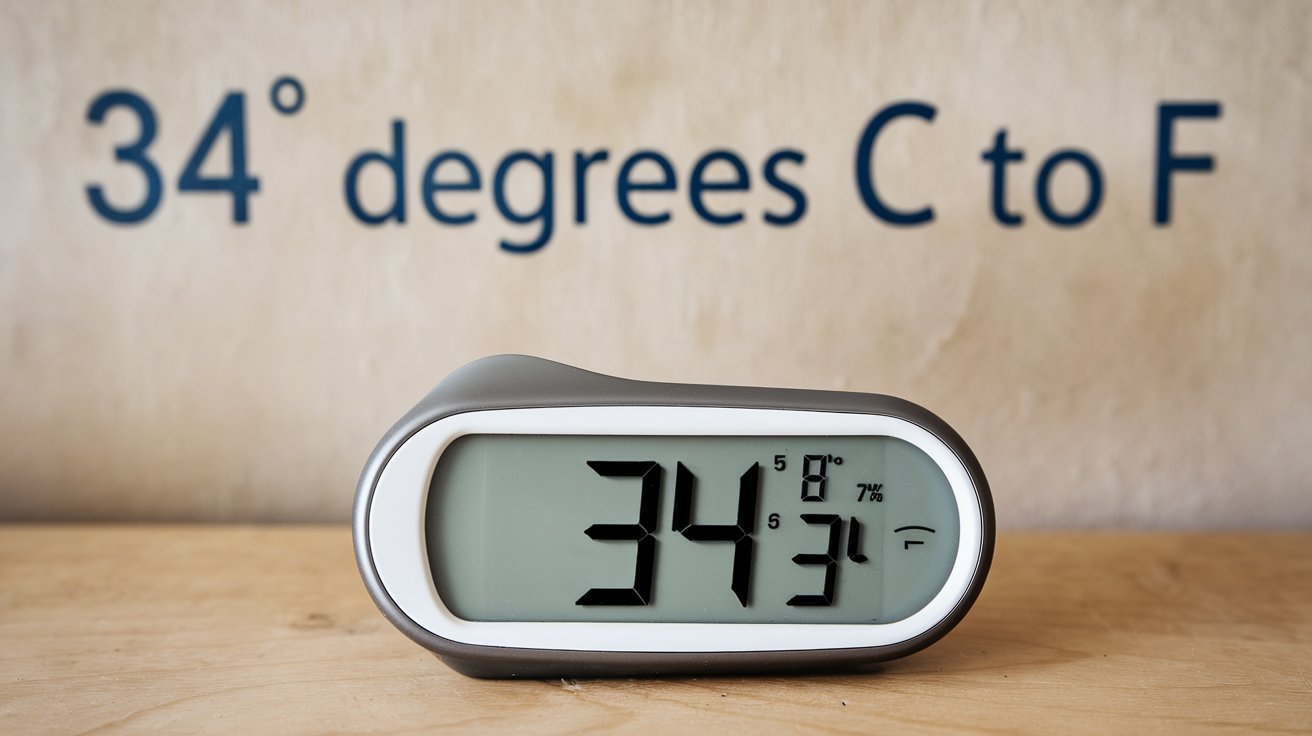Understanding 34 degrees c to f: A Complete Guide
Introduction
When it comes to temperature, understanding the differences between Celsius and Fahrenheit is crucial, especially when traveling or cooking. Today, we’re diving into the world of temperature conversions, focusing specifically on 34 degrees c to F. You might think it’s just a simple number, but the implications are far-reaching! Let’s explore the conversion methods and the history behind these temperature scales and sprinkle in some fun facts along the way.
What Is Celsius?
Celsius is a temperature scale used worldwide, particularly in scientific contexts. Developed by the Swedish astronomer Anders Celsius in 1742, it sets the freezing point of water at 0°C and the boiling point at 100°C. This scale is straightforward, making it easy for everyone to understand temperature changes in everyday life.
Simply put, if someone mentions 34 degrees C to F, they refer to a warm temperature, often associated with sunny weather. Imagine walking outside on a bright summer day; that’s the feeling at 34 degrees C to F! It’s like stepping into a warm hug from the sun, making you want to ditch your jacket and enjoy some outdoor fun.
What Is Fahrenheit?
Fahrenheit, on the other hand, is primarily used in the America. This scale was proposed by German physicist Daniel Gabriel Fahrenheit in 1724. On this scale, water solidifies at 32°F and turns to steam at 212°F. The difference between the two scales is substantial, and that’s where conversions come into play.
For those unfamiliar with Fahrenheit, 34 degrees c to F may seem perplexing. However, understanding how to convert it will clear up any confusion! Once you know the conversion formula, you’ll feel like a temperature wizard ready to tackle any weather report.
The Conversion Formula
To change Celsius into Fahrenheit, you can apply the formula:
F=(C×1.8)+32F = (C \times 1.8) + 32F=(C×1.8)+32
So, to convert 34 degrees c to F, you would plug in the numbers like this:
F=(34×1.8)+32F = (34 \times 1.8) + 32F=(34×1.8)+32
Doing the math, you’d find:
F=61.2+32=93.2°FF = 61.2 + 32 = 93.2°FF=61.2+32=93.2°F
This means 34 degrees c to F is equivalent to 93.2 degrees Fahrenheit. Now that’s a hot day! Whether you’re planning a picnic or a beach day, knowing this conversion can help you prepare appropriately.
Why Is This Conversion Important?
For various reasons, understanding how to convert 34 degrees c to F is essential. Knowing the Fahrenheit equivalent can help you plan your wardrobe better if you’re traveling to a country that uses Celsius. No one wants to step out in shorts when it’s pretty chilly!
Additionally, in cooking, recipes may call for specific temperatures in Fahrenheit. If you’re following a recipe and need to adjust the temperature from Celsius to Fahrenheit, having this knowledge can save you from culinary disasters.
Imagine attempting to bake a cake at the wrong temperature—yikes! You might end up with a burnt offering instead of a delicious dessert. So, let’s make sure we’re cooking at the right temperature!
Everyday Applications of Temperature Conversions
Cooking
Let’s say you’re trying to bake a cake. If your recipe states that the oven should be set to 34 degrees c to F, you’ll need to convert that to Fahrenheit to use your oven correctly.
In baking, precision is key! Knowing how to convert temperatures accurately can make the difference between a fluffy cake and a brick. If you mistakenly set your oven to 34°F instead, you might have a frozen disaster instead of a warm dessert!
Weather Forecasts
Imagine you’re watching the weather report while planning your weekend. If the meteorologist mentions 34 degrees c to F, you might want to dress for a hot day. Understanding that this translates to 93.2 degrees Fahrenheit helps you prepare with the proper clothing.
A hot day could mean shorts, tank tops, and plenty of sunscreen! Or a refreshing dip in the pool. Knowing the temperature can also help you decide on outdoor activities.
Health Monitoring
When monitoring body temperature, particularly during a fever, knowing how the scales work is essential. If your thermometer reads 0, converting it to Fahrenheit ensures you understand whether you’re dealing with a mild or severe health concern.
For example, a body temperature of 34°C (or 93.2°F) might indicate hypothermia, while a reading of 37°C (or 98.6°F) is generally considered normal. Understanding these differences can be a lifesaver—literally!
Fun Facts About Temperature
- Celsius is prevalent in most countries: The majority of the world uses Celsius, with the U.S. being one of the few holdouts for Fahrenheit. Next time you’re overseas, you’ll feel like a pro knowing how to convert temperatures!
- Fahrenheit’s odd freezing point: The freezing point of water at 32°F may seem arbitrary, but it was based on the temperature of a brine solution. Yes, brine! Who knew?
- The scale that meets at -40 Celsius and Fahrenheit are equal at -40. So if someone tells you it’s -40, there’s no need to convert; it’s the same on both scales! You can be the star of the conversation by pointing this out!
Common Mistakes When Converting
There are a few common pitfalls when converting 34 degrees c to F. One frequent error is forgetting to use the correct formula. Another mistake is misplacing decimal points, leading to significant reading errors.
To avoid these issues, double-check your calculations and ensure you’re using the correct formula every time. Practice makes perfect!
Examples of Temperature Conversions
Let’s explore a few examples to reinforce your understanding:
- 10°C to °F:
F=(10×1.8)+32=50°FF = (10 \times 1.8) + 32 = 50°FF=(10×1.8)+32=50°F - 20°C to °F:
F=(20×1.8)+32=68°FF = (20 \times 1.8) + 32 = 68°FF=(20×1.8)+32=68°F - 34°C to °F:
F=(34×1.8)+32=93.2°FF = (34 \times 1.8) + 32 = 93.2°FF=(34×1.8)+32=93.2°F
As you can see, the formula remains consistent, allowing for easy calculations! Whether planning a trip, cooking, or just curious, knowing how to convert is handy.
Practical Tips for Converting Temperatures
- Use online calculators: If math isn’t your strong suit, plenty of online tools are available for quick conversions. These can help you save time and guarantee precision.
- Familiarize yourself with critical temperatures: Knowing ordinary Celsius temperatures and their Fahrenheit equivalents can help you gauge conditions quickly. For instance, 0°C is freezing, and 100°C is boiling.
- Practice makes perfect: The more you practice converting temperatures, the easier it becomes. Try challenging yourself with random temperatures to build your confidence!
The Importance of Context in Temperature
Understanding context is vital. For instance, 34 degrees c to F might feel quite different depending on humidity levels. A dry 93.2 degrees Fahrenheit is more comfortable than a humid one, even if the numbers are the same.
Always consider factors like humidity and wind chill, which can significantly impact how temperatures feel. It’s not just about the number; it’s about how the environment makes you think!
The Science Behind the Scales
Both Celsius and Fahrenheit have their roots in scientific observations. Celsius is based on water’s properties, while various substances, including saltwater, influence Fahrenheit.
This scientific background can be fascinating! It shows how deeply temperature measurements are intertwined with everyday life. Understanding the science can give you a greater appreciation for these measurements.
Cultural Impact of Temperature Scales
The difference between Celsius and Fahrenheit also reflects cultural perspectives. For example, in countries where Celsius is standard, weather reports emphasize more practical applications of temperature, like how it affects daily activities.
Conversely, in the U.S., where Fahrenheit is used, people may perceive temperature differently, often confusing travelers. It reminds us how measurement systems can shape our experiences and expectations.
The Role of Technology in Temperature Conversions
In our digital age, technology has simplified the process of temperature conversions. Smartphone apps and voice-activated assistants can provide instant answers to conversion questions.
These advancements allow us to focus more on enjoying our lives rather than stressing over calculations. Want to know how hot it is in Fahrenheit? Just ask your phone!
Environmental Factors Affecting Temperature
Weather can be unpredictable, and temperature isn’t the only factor to consider. Humidity, wind speed, and even altitude can impact how we experience temperature. For example, 34 degrees c to F in a humid environment can feel much hotter than in a dry setting.
Understanding these nuances can help you dress appropriately, plan outdoor activities, and maintain comfort during different seasons.
conclusion
In conclusion, converting 34 degrees c to F might seem simple, but it opens up a world of understanding about temperature and its applications in our daily lives. Knowing the conversion formula and understanding both scales can enhance your experiences, whether cooking, traveling or just checking the weather.
So, the next time you hear 34 degrees c to F, remember that it translates to 93.2 degrees Fahrenheit. With this knowledge, you can impress your friends with your temperature conversion skills!
And let’s be honest, nothing beats a good conversation about temperature scales to break the ice—pun intended!
Stay calm or warm, and always embrace the challenges of temperature conversions. Happy converting! And who knows, maybe one day you’ll find yourself debating whether it’s better to measure temperatures in Celsius or Fahrenheit. You’ll be armed with facts and conversions, ready to defend your stance!














Post Comment